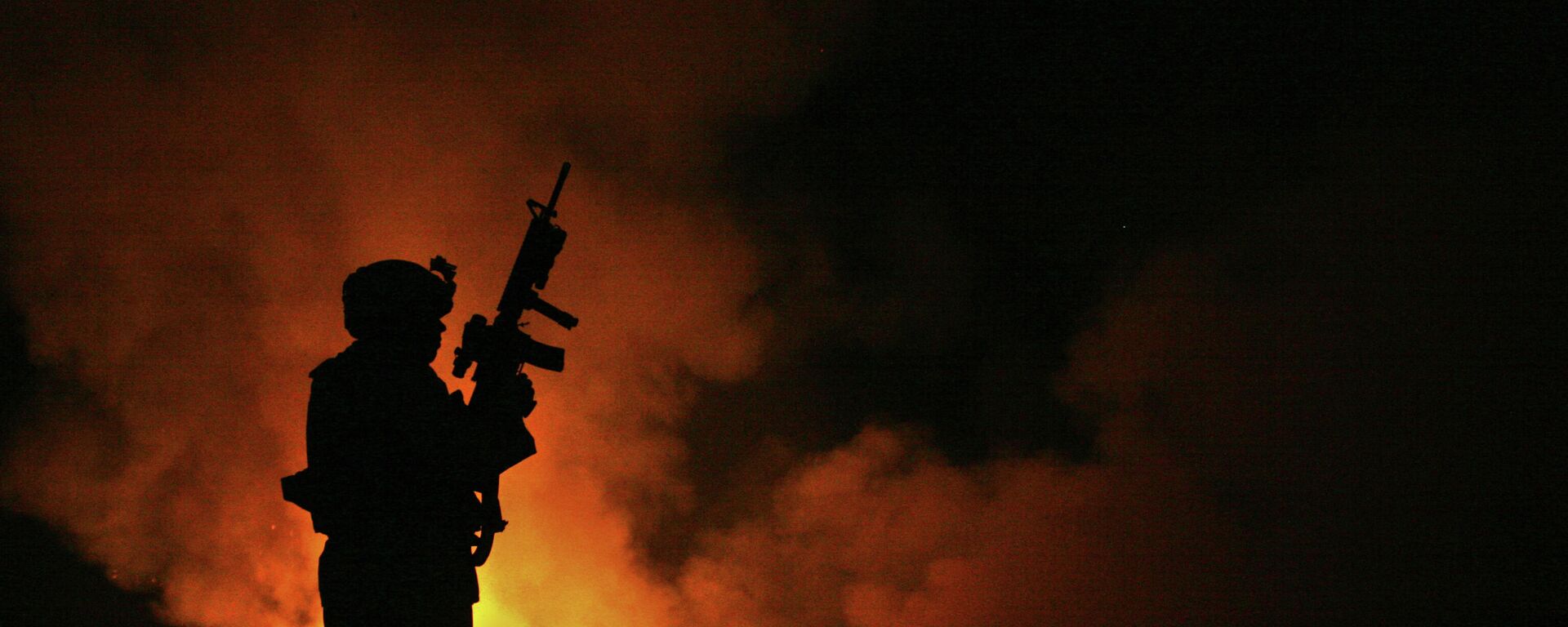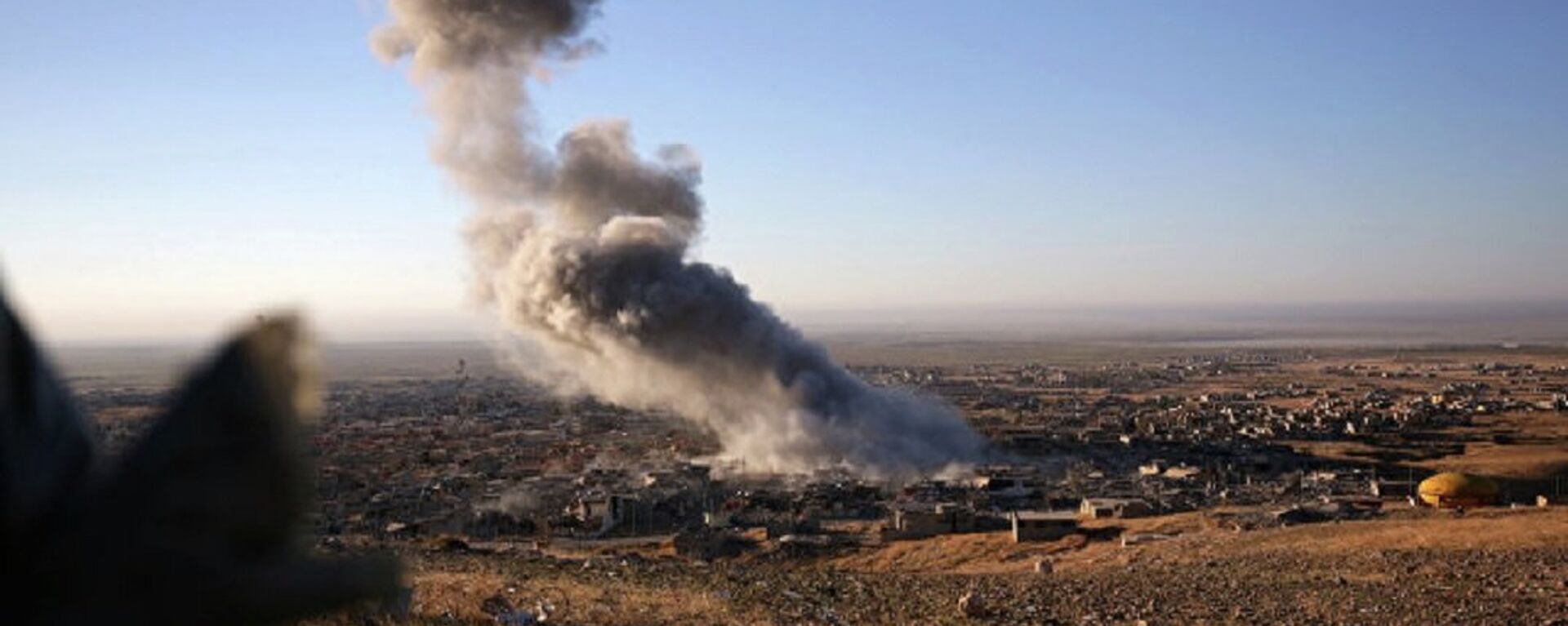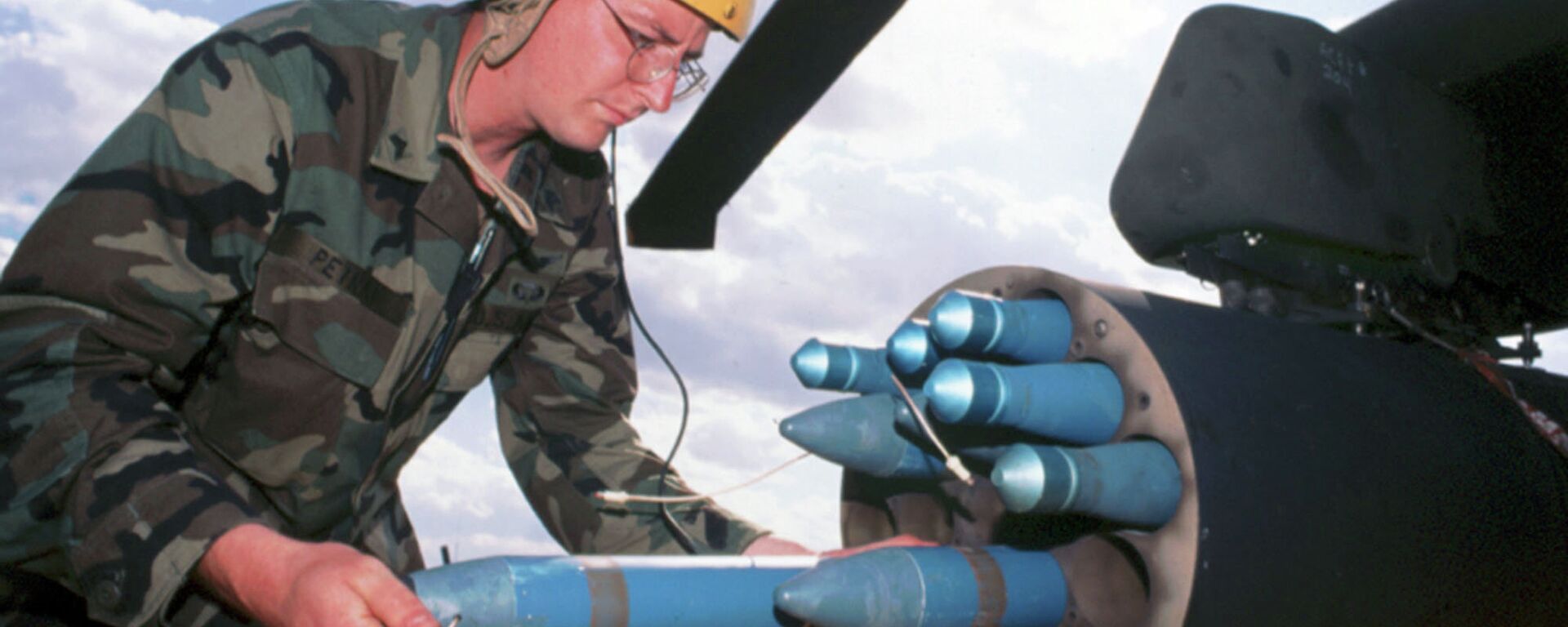https://sputnikglobe.com/20231014/what-is-white-phosphorus-that-israel-is-accused-of-using-in-gaza-strip-1114174368.html
What is White Phosphorus That Israel is Accused of Using in Gaza Strip?
What is White Phosphorus That Israel is Accused of Using in Gaza Strip?
Sputnik International
Amid the escalation in the Middle East, reports have emerged claiming that Israel has used white phosphorus in its military operations in the Gaza Strip. 14.10.2023, Sputnik International
2023-10-14T16:57+0000
2023-10-14T16:57+0000
2023-12-05T09:22+0000
military
igor nikulin
geneva
sputnik
shell
chemical weapons convention
israel
world
israel defence forces (idf)
israel defense forces (idf)
https://cdn1.img.sputnikglobe.com/img/105313/14/1053131445_0:161:3071:1888_1920x0_80_0_0_6fae07879e5b9051eb6379925d6378e2.jpg
In course of the ongoing military escalation of the Palestine-Israel conflict, Human Rights Watch has alleged that the Israel Defense Forces have deployed munitions with white phosphorus, stating that using these munitions endangers the safety of civilians, causing severe and enduring injuries.When asked about the allegation by media sources, the Israeli ambassador to Russia, Alexander Ben Zvi, stated that "it must be refuted. It is not true. Nowadays, you know, everyone is on social media, and everyone has a mobile phone. It is merely nonsense."White phosphorus has been controversial in warfare for decades - it raises ethical and legal questions, sparking debates on its strategic advantages versus potential harm, as it inflicts horrendous tormenting burns on its victims.Sputnik dissects the complexities of white phosphorus ammunition, exploring its composition and the multifaceted considerations surrounding its deployment on the battlefield.What is White Phosphorus?White phosphorus, characterized chemically as P4, is a highly reactive and flammable chemical element and spontaneously combusts upon exposure to air. Its pure form is that of a waxy solid, translucent in nature, and featuring a distinct pale-yellowish coloring. It has an approximate density of 1.82 grams per cubic centimeter (approx. 0.065 pound per cubic inch). The chemical's molecular structure comprises four phosphorus atoms arranged in a pyramid-like configuration.It maintains a solid form at standard room temperature but undergoes a phase transition at around 44.1oC (111.4 oF), converting into a highly reactive gaseous state. White phosphorus is also hazardous to humans and can cause severe burns upon contact with the skin.What Types of Ammunition Contain White Phosphorus? White phosphorus munitions employ one of the primary forms of the element phosphorus. White phosphorus serves multifaceted roles in ammunition, such as creating smoke screens, offering illumination for troops in low-light situations, and acting as a vital ingredient in incendiary munitions. Notably, it's the primary burning component in munitions with a built-in explosive primer at their base.Smoke-producing white phosphorus munitions are a common sight on the battlefield. They serve various purposes, from infantry smoke grenades to protective grenade launchers mounted on tanks and armored vehicles, forming a component of the ammunition cache for artillery and mortars.According to public information, white phosphorus can be found in several munition categories:Composition of White Phosphorus MunitionsWhite phosphorus ammunition is usually housed in a casing, which can be crafted from various materials, including metal. White phosphorus can come as a gel, powder, or solid inside this container. Other components of white phosphorus munitions, besides the incendiary substance, include:Shell and Filling: The standard munition comprises a shell enclosing the white phosphorus payload. This covering is typically a metal, like steel or aluminum, designed to hold the chemical until it is deployed. The casing may have additional components for stability during flight and impact.Ignition Mechanism: In many situations, an additional igniting agent is integrated to ensure the detonation occurring unhindered when the substance is dispersed. This could be a small explosive charge or a chemical compound designed to assist in ignition.Detonator: If present, the detonator is a small device used to initiate the explosive component of the munition, which can help disperse the white phosphorus upon impact.Stabilization and Deployment Systems: Depending on the particular design, the munition might require stabilization fins or other tools to steer its flight. Also, it could include a deployment system like a parachute or timer to control when and how the white phosphorus is let out.Fuse: Some white phosphorus munitions have a fuse mechanism that controls the timing of the explosion. This can be set to achieve specific effects, such as airburst or ground impact.Effects of White Phosphorus Munitions on HumansThe deployment of white phosphorus ammunition causes a range of devastating damages, leaving severe effects on both humans and the environment. These effects arise from its unique property of igniting upon contact with air, generating intense heat and a reactive chemical compound.Effects on Humans Include:Effects on Environment:Who Bans and Who Uses White Phosphorus Munitions?The escalation of the Palestine-Israel conflict came after Hamas launched an attack on Israel on October 7. In response to Hamas' unexpected attack, the Israeli government officially declared a state of war. They authorized substantial military action to counter the threat to southern towns and escalated airstrikes on the Gaza Strip, prompting a reaction from various human rights groups.Under international law, white phosphorus is prohibited for specific uses because of its severe and indiscriminate effects on combatants and civilian populations and its potential to cause devastating damage or losses.Consequently, there are international legal frameworks that address the use of white phosphorus, including:The United States did not initially sign Additional Protocol I and II of 1977 to the Geneva Conventions. These protocols aimed to provide additional protections for victims of armed conflicts, including rules on the use of certain types of weapons and the treatment of civilians and non-combatants.He also recalled that the Ukrainian Armed Forces deployed phosphorus munitions "on the territory of the DPR both before and during this conflict ... in the Zaporozhye region, the Kherson region," as "Ukraine adheres to the same barbaric views on the ways of waging war as the United States."
https://sputnikglobe.com/20220828/darpa-to-create-new-invisibility-cloak-smokescreen-for-us-military-instead-of-white-phosphorus-1100087740.html
https://sputnikglobe.com/20181013/coalition-white-phosphorus-1068856593.html
https://sputnikglobe.com/20190911/photo-us-air-force-investigating-white-phosphorus-rockets-found-on-road-1076778864.html
https://sputnikglobe.com/20220429/british-army-representative-admits-use-of-highly-toxic-white-phosphorus-in-kenya-report-says-1095155742.html
geneva
israel
world
lebanon
gaza strip
Sputnik International
feedback@sputniknews.com
+74956456601
MIA „Rosiya Segodnya“
2023
Chimauchem Nwosu
https://cdn1.img.sputnikglobe.com/img/07e7/09/01/1113046371_0:99:1536:1635_100x100_80_0_0_9c5c627283eca931c39fe4852bbb301c.jpg
Chimauchem Nwosu
https://cdn1.img.sputnikglobe.com/img/07e7/09/01/1113046371_0:99:1536:1635_100x100_80_0_0_9c5c627283eca931c39fe4852bbb301c.jpg
News
en_EN
Sputnik International
feedback@sputniknews.com
+74956456601
MIA „Rosiya Segodnya“
Sputnik International
feedback@sputniknews.com
+74956456601
MIA „Rosiya Segodnya“
Chimauchem Nwosu
https://cdn1.img.sputnikglobe.com/img/07e7/09/01/1113046371_0:99:1536:1635_100x100_80_0_0_9c5c627283eca931c39fe4852bbb301c.jpg
igor nikulin, geneva, sputnik, shell, chemical weapons convention, israel, world, israel defence forces (idf), israel defense forces (idf), newsfeed, middle east, palestinians, lebanon, hamas, human rights watch, al-aqsa mosque, palestine-israel conflict, gaza strip
igor nikulin, geneva, sputnik, shell, chemical weapons convention, israel, world, israel defence forces (idf), israel defense forces (idf), newsfeed, middle east, palestinians, lebanon, hamas, human rights watch, al-aqsa mosque, palestine-israel conflict, gaza strip
What is White Phosphorus That Israel is Accused of Using in Gaza Strip?
16:57 GMT 14.10.2023 (Updated: 09:22 GMT 05.12.2023) Amid the escalation in the Middle East, reports have emerged claiming that Israel has used white phosphorus in its military operations in the Gaza Strip.
In course of the ongoing military escalation of the
Palestine-Israel conflict, Human Rights Watch has alleged that the Israel Defense Forces have deployed munitions with white phosphorus, stating that using these munitions endangers the safety of civilians, causing severe and enduring injuries.
This allegation was repudiated by the IDF's spokesperson, who said, “The current accusation made against the IDF regarding the use of white phosphorus in Gaza is unequivocally false. The IDF has not deployed the use of such munitions.”
When asked about the allegation by media sources, the Israeli ambassador to Russia, Alexander Ben Zvi, stated that "it must be refuted. It is not true. Nowadays, you know, everyone is on social media, and everyone has a mobile phone. It is merely nonsense."
White phosphorus has been controversial in warfare for decades - it raises ethical and legal questions, sparking debates on its strategic advantages versus potential harm, as it inflicts horrendous tormenting burns on its victims.
Sputnik dissects the complexities of white phosphorus ammunition, exploring its composition and the multifaceted considerations surrounding its deployment on the battlefield.

28 August 2022, 13:32 GMT
What is White Phosphorus?
White phosphorus, characterized chemically as P4, is a highly reactive and flammable chemical element and spontaneously combusts upon exposure to air. Its pure form is that of a waxy solid, translucent in nature, and featuring a distinct pale-yellowish coloring. It has an approximate density of 1.82 grams per cubic centimeter (approx. 0.065 pound per cubic inch). The chemical's molecular structure comprises four phosphorus atoms arranged in a pyramid-like configuration.
It maintains a solid form at standard room temperature but undergoes a phase transition at around 44.1oC (111.4 oF), converting into a highly reactive gaseous state. White phosphorus is also hazardous to humans and can cause severe burns upon contact with the skin.
What Types of Ammunition Contain White Phosphorus?
White phosphorus munitions employ one of the primary forms of the element phosphorus. White phosphorus serves multifaceted roles in ammunition, such as creating smoke screens, offering illumination for troops in low-light situations, and acting as a vital ingredient in incendiary munitions. Notably, it's the primary burning component in munitions with a built-in explosive primer at their base.
Smoke-producing white phosphorus munitions are a common sight on the battlefield. They serve various purposes, from infantry smoke grenades to protective grenade launchers mounted on tanks and armored vehicles, forming a component of the ammunition cache for artillery and mortars.
"Firstly, it is a poisonous substance. And secondly, it leaves extremely severe wounds. It should be extinguished either with wet sand or with a large amount of water. There are no other options. Phosphorus shells are designed to set fires, set fire to premises, smoke out of shelters, and so on," acknowledges Igor Nikulin, military expert, former member of the UN Commission on Chemical and Biological Weapons.
According to public information, white phosphorus can be found in several munition categories:
Bombs - M47A1, AN-M47A2, AN-M47A3, CBU-55/B, CBU-78/B, etc.
Rockets - M156, M259, Mk 67 Mod 0, etc.
Artillery shells - M825/M825A1, M110A1, M110A2, M104, etc.
Mortar shells - M106 4.2-inch Mortar Smoke Projectile, M68 120 mm Smoke White Phosphorus, M929 120 mm Smoke White Phosphorus, etc.
Different types of grenades - M34, No. 77 Mk1, No. 80 Mk1, No. 81 Mk 1 - White phosphorus hand grenades, etc.
Composition of White Phosphorus Munitions
White phosphorus ammunition is usually housed in a casing, which can be crafted from various materials, including metal. White phosphorus can come as a gel, powder, or solid inside this container. Other components of white phosphorus munitions, besides the incendiary substance, include:
Shell and Filling: The standard munition comprises a shell enclosing the white phosphorus payload. This covering is typically a metal, like steel or aluminum, designed to hold the chemical until it is deployed. The casing may have additional components for stability during flight and impact.
Ignition Mechanism: In many situations, an additional igniting agent is integrated to ensure the detonation occurring unhindered when the substance is dispersed. This could be a small explosive charge or a chemical compound designed to assist in ignition.
Detonator: If present, the detonator is a small device used to initiate the explosive component of the munition, which can help disperse the white phosphorus upon impact.
Stabilization and Deployment Systems: Depending on the particular design, the munition might require stabilization fins or other tools to steer its flight. Also, it could include a deployment system like a parachute or timer to control when and how the white phosphorus is let out.
Fuse: Some white phosphorus munitions have a fuse mechanism that controls the timing of the explosion. This can be set to achieve specific effects, such as airburst or ground impact.

13 October 2018, 11:56 GMT
Effects of White Phosphorus Munitions on Humans
The deployment of white phosphorus ammunition causes a range of devastating damages, leaving severe effects on both humans and the environment. These effects arise from its unique property of igniting upon contact with air, generating intense heat and a reactive chemical compound.
Effects on Humans Include:
1.
Burns: One of the most significant dangers of white phosphorus exposure is severe thermal or chemical burns. When ignited, it produces intense heat, causing deep and painful burns. These burns can be particularly difficult to treat as white phosphorus can reignite upon contact with air.
2.
Toxic Inhalation: Inhaling the fumes or smoke of this chemical substance can lead to respiratory issues and lung damage. It releases phosphoric acid, which can irritate the respiratory system and lead to complications.
3.
Systemic Toxicity: White phosphorus can be absorbed through the skin and mucous membranes. It can cause systemic effects, affecting various organs and systems in the body. This can lead to serious health complications.
4.
Long-Term Health Effects: Chronic exposure to white phosphorus can lead to long-term health issues, including respiratory problems, and increased risk of certain cancers.

11 September 2019, 19:00 GMT
1.
Soil and Water Contamination: White phosphorus can contaminate soil and water when munitions are used. This can have long-lasting effects on the ecosystem, impacting plant and animal life.
2.
Air Pollution: The combustion of white phosphorus releases toxic gases, including phosphoric acid and phosphine. These can contribute to air pollution, potentially affecting human and environmental health.
3.
Persistent Residue: White phosphorus can persist in the environment for extended periods, especially in soil and sediments. This can continue to pose a threat to both wildlife and humans over time.
4.
Contamination of Food Chain: White phosphorus can enter the food chain through plants or animals that have been exposed to contaminated soil or water. This can lead to indirect exposure for humans and wildlife.
Who Bans and Who Uses White Phosphorus Munitions?
The escalation of the Palestine-Israel conflict came after
Hamas launched an attack on Israel on October 7. In response to Hamas' unexpected attack, the Israeli government officially declared a state of war. They authorized substantial military action to counter the threat to southern towns and escalated airstrikes on the Gaza Strip, prompting a reaction from various human rights groups.
Under international law, white phosphorus is prohibited for specific uses because of its severe and indiscriminate effects on combatants and civilian populations and its potential to cause devastating damage or losses.
"The fact that it burns with a high temperature, about 1,300 degrees. And it is absorbed into the human body. That is, firstly, it is a toxic substance, and secondly, it really leaves unhealed wounds. Therefore, these weapons are considered barbaric and extremely indiscriminate. And it is precisely the Geneva Protocol of 1977 that prohibits its use if civilians may suffer," said Nikulin.
Consequently, there are international legal frameworks that address the use of white phosphorus, including:
The
Convention on the Prohibition of the Development, Production, Stockpiling and Use of Chemical Weapons and on Their Destruction, commonly known as the Chemical Weapons Convention (CWC), is an arms control treaty that came into force on April 29, 1997.
The United States did not initially sign Additional Protocol I and II of 1977 to the Geneva Conventions. These protocols aimed to provide additional protections for victims of armed conflicts, including rules on the use of certain types of weapons and the treatment of civilians and non-combatants.
"If they are going to apply them, why would they sign? They are not going to remove these shells, bombs from weapons. They keep using, so of course they won't sign. As a rule, America signs an agreement if its opponents begin to get ahead of it in some way. When we started to get ahead in missiles, bombs and so on, that's when they will sign," argued Nikulin, while responding to why the United States did not ratify certain additional protocols to the Geneva Convention in 1977.
He also recalled that the Ukrainian Armed Forces deployed phosphorus munitions "on the territory of the DPR both before and during this conflict ... in the Zaporozhye region, the Kherson region," as "Ukraine adheres to the same barbaric views on the ways of waging war as the United States."









